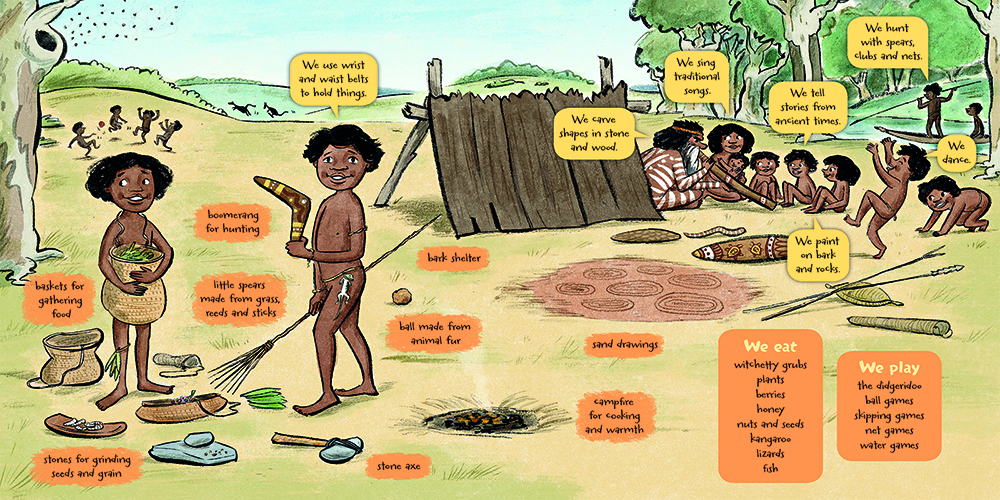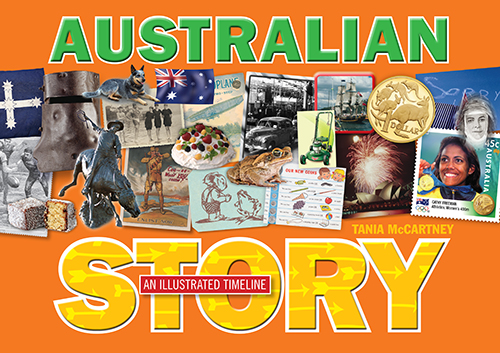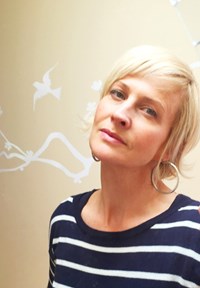Issue 97
Term 2 2016
Exploring time and place through children's literature
Tania McCartney reflects on the mind-opening nature of diverse children’s literature, looking at how exposure to other cultures and earlier times can impact children’s minds.

Illustrations from Tania McCartney's book Australian Kids through the Years
Books can enrich children’s lives beyond measure.
Exposure to other people and cultures, whether directly or indirectly, does extraordinary things to children. It opens their heads and crams wonderful things inside. It relaxes their hearts, softens their emotional boundaries, and enriches their minds with alternative ways of thinking and being.
In a world that so often teeters on intolerance and segregation, it’s vital for children to be exposed to different ways of thinking and being. It is also vital that this exposure happens at a young age and stretches across many and varied multicultural experiences; before time, world-weariness, and bias have a chance to take root.
Immersion in other cultures stretches the malleable brains of children in ways we can never truly imagine. Experiencing new places and people, situations and sights, foods and smells, are all wonderful ways to take children outside their comfort zone and both enrich and delight them. I believe this because I have seen it first-hand, having both lived overseas and travelled extensively with my own children.
I’ve watched my children’s heads figuratively open wide and suck in the nuance, tolerance and minutiae of life in other places. I’ve watched their palettes shift like a continental drift from Australia to China. I’ve watched their fears drip from their sopping hair into the Indian Ocean. I’ve watched their understanding of human rights, privilege, and timeworn tradition echo in the halls of Notre Dame Cathedral and slip along the shores of Tonle Sap Lake in Cambodia.
I’ve watched my children become entirely different people. These experiences not only expand our children’s tolerance and understanding of other cultures and traditions, but they also shift the way they view their own worlds. These experiences shape who they are, and who they become.
Alas, we can’t always travel willy-nilly around the country or around the world at whim, but something almost as powerful as jumping on a plane and entering other lands, other cultures, other places, and other times, is when we journey through the pages of a book.
From picture books to biography, encyclopaedias, non-fiction, and historical tomes, exposing children to other countries and cultures does indeed encourage other ways of being and thinking. Travelling into the past is also valuable, as it helps us understand where we have come from, who we are now, where we are going, and how we can improve.
Again, we don’t need a time machine for this — we just need a book.
I didn’t expect to write so many books with a multicultural and historical focus. I guess it’s no surprise since they are both topics dear to me, but it wasn’t a conscious decision. It all began when our little family was posted to Beijing in 2005.
When we arrived, two unexpected things happened: the first was that I fell head over heels in love with China, and the second was that I became immensely patriotic for Australia. When you live away from home, some kind of homeloving bug burrows under your skin. This is what inspired me to write the first of my books in the multicultural vein.
I wrote An Aussie Year: Twelve Months in the Life of Australian Kids not only to take children on a journey through the Australian year, but also through the vast multicultural elements that comprise our country. After its publication in 2013, it went on to become a bestseller, won several awards, and was recently shortlisted in the Western Australia Young Readers’ Book Awards. Illustrator Tina Snerling and I have since gone on to produce another six books in the A Kids’ Year series, including An English Year and A Scottish Year, which are doing well here in Australia.
I guess it should be no surprise, though, as Australian children are not only culturally diverse, they are some of the best-travelled in the world. They’re the ultimate little adventurers, and love to explore new worlds and cultures. They’re inherently fascinated by the unusual, the unknown, the ways of other people and times. They are fresh and ripe and open, which is why we need to open their eyes to the world — the younger the better. This is why I write for children, and why I write about the topics that I do: not only to entrance and entertain, but also to educate.

Australian Story: An Illustrated Timeline, by Tania McCartney
I spent almost 18 months researching and writing Australian Story: An Illustrated Timeline for the National Library of Australia. I knew that children would relish being picked up and tossed back through time, and to experience their country and a way of life so different from the now. From our First People through to settlement and in great periods of early migration — from the Chinese of the Gold Rush to the post-war influx of Eastern Europeans, Western Europeans, people from Asia and then the Middle East — this ‘time travelling’ book is rich in the cultural exploration and self-realisation that children adore. Learning about our own cultural roots, ancestry and traditions is a great way for children to make connections, and to feel pride and comfort.
Australian Kids through the Years, another recent National Library book illustrated by Andrew Joyner, was born of a similar need to help children both define their own identity and appreciate and understand the identities of those around them. We are so fortunate in Australia to have an enriching stew of cultural influences that shape our own ethnic identities. According to our last Census figures, more than 25% of Australians are born overseas (ABS, 2012). Twenty per cent of Australians have at least one parent who was born overseas, and more than 400 languages are spoken on our shores (ABS, 2012; ABS, 2011). These figures alone are worth celebrating.
With Australian Kids through the Years, I wanted to explore children from our First Peoples through to modern day. I wanted to show our children how we have grown and developed over time — how what we wore, ate, read, and played with has changed exponentially — yet so many of our core values and needs remain the same. I also wanted to highlight that many of these changes and much of our growth as a nation has been directly influenced by other races and cultures.
Children learn about their world through the context of other people and other beliefs, traditions and cultural practices. We are social beings, so when children value and respect these elements in others, they are much more likely to develop a deeper sense of belonging and community. Feeling connected to others makes us feel valued and respected, and it is also vital for our emotional and mental wellbeing.
Early childhood is the period when children first become aware of their differences, which is something that they naturally find fascinating. At this formative time in their lives, to encourage an open mind and acceptance of these differences through exposure to other times and cultures in books, is a priceless gift.
In a nutshell, children who are consistently exposed to multicultural books have broader minds and a deeper understanding of both the self and others. They have a greater willingness to explore and experience life to its fullest, and to pursue friendship, relationship, and career opportunities that are not bound by prejudice, stereotypes, or limited thinking.
And, of course, global awareness is necessary in this ever-shrinking world. The more cultural diversity children interact with, the larger their world — and opportunities — become.
Culturally rich books provide more flavour for children, who naturally have fresh, young tastebuds and such a voracious appetite for books and story. Like the blending of colours and flavours from the cultures all around us, it is a perfect combination.
Ideas for exploring diverse books with students
Research and source books that relate to one particular culture and use them to make a visual display, along with any relevant non-book objects. Ask students to bring in items they may have that relate to this culture, such as clothing, toys or foods.
Children from a particular culture could share books or stories that they or their parents have grown up with. Children could also find relevant stories and read them to the class, or draw pictures about them.
Display a variety of atlases and have a world map or globe close by so that students can explore a variety of countries. Print out world maps that students can colour in as they explore each place.
Scour encyclopaedias or fact books and explore the main symbols of a variety of countries — such as flags, languages, national mottos, foods, flora and fauna.
Explore books and songs in other languages or teach students how to say hello in various tongues.
References
- Australian Bureau of Statistics 2011, ‘2011 Census fact sheet’, ABS,www.abs.gov.au/websitedbs/D3310114.nsf/home/2011%20Census%20Fact%20Sheet:+Ethnic.
- Australian Bureau of Statistics 2012, ‘Reflecting a nation: stories from the 2011 Census, 2012–2013’. ABS,www.abs.gov.au/ausstats/[email protected]/Lookup/2071.0main+features902012-2013.
Image credits
- Australian Story: An Illustrated Timeline by Tania McCartney. © 2012 National Library of Australia.
- Pages from Australian Kids through the Years by Tania McCartney. © 2015 National Library of Australia.
